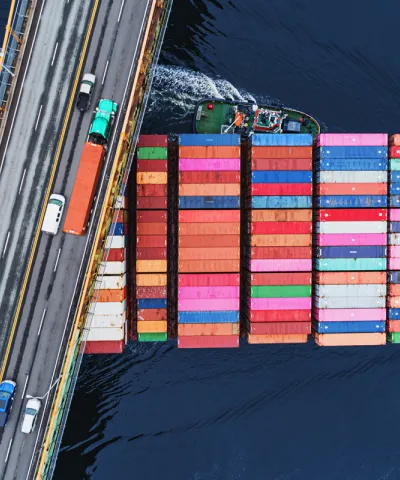Transcript
[00:00:04] Narrator Welcome to The Better Growth Blueprint, a new podcast series from Simon-Kucher, a global consulting firm that focuses on helping our clients grow sustainably, increasing revenue and profit. Throughout this series, we will look at key trends shaping the future of business. We will cover all major sectors, giving you a full view of what's happening in the market and what you need to do to stay ahead. In today's episode, Kai is joined not by one but by two guests, Grigori Bokeria and Adam Echter, Global Co-heads of Industrials, Grigori and Adam bring their expertise from Europe and the United States. And one of the topics they dive into is the similarities and differences between these two regions. They also cover how volatility can lead to a demand crisis and what to do about it, what dynamic pricing looks like in the industrial sector and much more, as we look ahead to 2025. Now over to your host, Kai Bandilla, a senior partner based in Paris.
[00:01:04] Kai Bandilla Welcome back to our podcast. Exciting podcast today. I'll be meeting two guys, actually. One is American. One is German. But both have a common passion, which is industry. And it may be Grigori and Adam introduce themselves and you will decide who of them is the one sitting in the U.S. right now and who is the other one sitting somewhere in Germany?
[00:01:26] Grigori Bokeria Yes. Hello, everybody. I'm Grigori. Kai, thanks for the intro. I'm very passionate about industrials. And by the way, to let you know what we mean by industrials is that we are covering the entire value chain from the raw materials until the very end of the value chain coming straight before the consumer. So it's about raw material construction, about automation, about machinery stuff, about paper packaging, logistics, business services. These are all the things we Adam Echter are passionate when it comes to industrials. And I'm sitting in Cologne in the heart of Germany, in the heart of Europe.
[00:02:08] Kai Bandilla And Adam, where are you sitting this morning?
[00:02:11] Adam Echter Greetings, everybody. This is Adam Echter, coming to you from Silicon Valley, California, lead our industrial practice. And that is anything that has to do with the heavy industries. So if it's big, loud, makes noise, that's us. Been doing this for my entire career. Started in steel mills and power plants, and now I get to work across the whole spectrum of industrial businesses.
[00:02:30] Kai Bandilla Interesting perspective. So you're covering different continents, covering different expectations. So that brings me to this idea of maybe you sharing a bit how you see 24 ending. And then much more important, how do you see 25 starting. Other differences between Europe and the US and Asia? Are we all having the same types of troubles? Adam, how you see it in the US?
[00:02:57] Adam Echter Yeah, I think the economies are obviously different across those geographies, but the technology is, is more universal. So from our seats here in the States, I know we have ups and downs. We're having a rate cut recently, presidential election that resolve itself here in Q4. So I believe there's a lot of optimism for 25, but there's going to be a bit of a 24s spent really battening down the hatches, a lot of inside the plant work, a lot of ways to look for efficiency and gains in what you're doing from an operations perspective. Thinks 25 is going to put us back on a growth trajectory with companies expecting more expansion. Might be a different story across the pond. Germany's kind of ping pong between GDP growth and decline, and I think that affects how they would think about levels of investment, the risk taking in the industrial space when you're bringing new products and new services to market. And then APAC, there's so much growth over there and they're kind of driven by other macro factors. Our footprint there is small but growing. And again, we see the technology being universal, which is really about industrial companies embracing a lot more digital overlays, a lot more information. There's a reason I'm in Silicon Valley. You're seeing every piece of equipment, have some form of software or some form of data coming off of it these days, that's taken for granted. But we're only now getting to a point of figuring out how to monetize that.
[00:04:20] Kai Bandilla Technology, being kind of the key value driver in top line growth, Grigori, is it the same across the world. Are we talking about one basically common top line challenge across the world, or do you believe that this is rather different in Germany or in Europe than it is in the US today?
[00:04:42] Grigori Bokeria I think it's it's not fundamentally different. Right. So as Adam mentioned, we are experiencing here in Europe kind of a roller coaster ride when it comes to the, let's say, macro trend, like GDP up, GDP down. And obviously, all these c-level executives have to cope with this. And we see here the clear demand crisis, which obviously leads to certain challenges because you have to adapt basically your complete operating model to this kind of challenge when you are facing it, that the revenues are not there anymore, at least not at the expense that were in the last 12 or 18 or 24 months. And this is basically the major challenge we are seeing outside in the markets, talking with the different CEOs, CFOs, CSOs of our clients.
[00:05:39] Kai Bandilla You talk about demand crisis, Grigori. What are the origins of this demand crisis? Is this that we don't have the right products anymore? Is it like German car manufacturers not being able to have interesting EVs? Or is this because there is volatility, uncertainty and people just hold back and don't buy?
[00:05:58] Grigori Bokeria We see an overlap of different trends and crises. In order to get this, I think it's important to look maybe a little bit backwards and understand that in the last 12 months there were kind of allocation of the sales. Because there were supply chain crisis, everybody wanted to get some portion of their supplies and they were kind of pushed into the allocation by their suppliers. And by this they doubled a little bit of their their their portions in order to get this supply. And basically, all the inventories, this is at least what the clients are saying and what we also see in the data there are full. So that means that the customers are not purchasing right now because there is obviously a low demand in the market for whatever reasons, and this low demand of the market is coming on the one hand, obviously from the increased interest rates, which makes certain investments, certain projects maybe not that attractive anymore, the breakeven is shifted. On the one hand, on the other hand, there are obviously also certain geographies out there that are also experiencing a sudden downturn. And based on this, all this mix is coming up, but we are ending in a sudden demand crisis.
[00:07:21] Kai Bandilla So the idea is basically to bring back trust. And probably, Adam, you just mentioned it. The rate cuts in the US are maybe the first step into the right direction, right? How is supply and demand in the US playing right now? Are we having a demand crisis like Grigori, you just explained it for some of the markets in Europe.
[00:07:47] Adam Echter That might be a little bit different in the States. There was a nice headline recently about McDonald's being overpriced, and that it's losing customers. And I think that was a good example of our position, is that with the effects of inflation settling in and now stabilized prices have gone up quite a lot. So people can visually see a a price change. In the case of McDonald's, again, you go, it's a small amount, but when you go from a four-dollar hamburger to a six dollar hamburger, people notice it. The value communication hasn't caught up. And so mostly, I think what we're working through stateside is helping companies remind their customers of the value they provide, highlight, and show that so that they can return to balance because it's all about the perception of price and value. And what we've seen in the last few years is a rapid move in the perception of price and maybe that communication of value is lagged a bit, but we're still trying to get that out back to the market across lots of different industrial clients.
[00:08:49] Kai Bandilla As we turn into 25, looking at the industrial businesses across the world, what are guys, Grigori, Adam, commonalities? What is common to the challenges that we face across the pond?
[00:09:06] Grigori Bokeria When I think of or what should first in my mind is definitely the volatility. What I mean by this is that it is for the c-suite really, really difficult to plan well ahead. So, the main challenge is that you have to react more quicker on certain developments and you simply can have a kind of a five-year strategy ahead. So it's much more time you have to think of. And this volatility brings to the table that the decision makers have to cope with different aspects at the same time. This is I guess this is somewhat normal to cope with different aspects and the same time. But what I mean by this is simply that, you know, if, if if you build up a triangle and say, okay, on the one hand you have to cope with sale side, on the other hand you have to cope with the costs and the profitability side and then on the third hand, you have to cope with the cash. And it seems, at least when I'm talking to the different decision makers out of the industrial space, that they're trying to balance all these three angles at the same time. You have to really balance your sales positions and say, okay, where to push, where to push the sales, where to gain volumes in the market. But at the same time, due to [00:10:35] the fact that [0.4s] there are not so many volumes in the market where to really adjust the costs, commercial cost, SG&A costs at the same time and obviously also to be very strict on your cash positions in order not to go bankrupt. Right. So this is really a balancing game that the decision makers have to talk and to really execute in 2025 in order to be really, really, really up and ahead of the wave.
[00:11:05] Kai Bandilla Grigori, this is an interesting point you're making. If I just sum it up, you said throw away a five-year plan, right? I mean, you need to be more dynamic in adapting to a market which cannot be foreseen any more for five years. Interesting thought. Adam, is it five years in the US? Is it three years? Is it eight years?
[00:11:25] Adam Echter The duration is less relevant. I think the core point is adaptability and agility is coming in significantly in the maybe back half of the 2020s. If we think about the 2010s, a tremendous period of stability. You can look at interest rates were at record lows for a long period of time. We added more than a ten-year bull market in North America, and we had low inflation. The ten-year average from 2010 to 2020 was about 1.8. That all went right out the window at the start of the 2020s. We had Covid, we had supply chains, we had inflation. And what that revealed to people was largely an underinvestment and maybe the pricing function for that decade led to outdated systems and a lack of agility. And so what we saw really surge in in 2020 to 2023 was companies investing heavily to get some agility back into their pricing after they responded to the inflationary spike with brute force. They realized they had to build systems to increase their agility, and I think that's going to continue going forward.
[00:12:32] Kai Bandilla So, Adam, you're not using the word dynamic pricing. I was believing that that would be the next piece of thought. Right? But does this mean that we need to be more dynamic in the way we price our value offerings in uncertain, volatile industrial world?
[00:12:52] Adam Echter Absolutely. But I think the definition of dynamic is what's up for debate. A lot of times you'll hear something like that, and you'll think of a rideshare platform that's real time updating both sides, the driver and the passenger with price points millions of times a day all over the planet. And that's really cool. And we can do that today. Most industrial businesses don't need that. If you used to reset your price list once a year and now you do it once a quarter, that's more dynamic. If you used to have one surcharge and now you have a list of five surcharges that you can deploy in different situations, that's more agile. And these are the things that I see really kind of coming into the forefront in industrial businesses around the world is it's not always about what's next on the cutting edge of technology. It's about taking things that have been proven and socialized elsewhere consumer products, financial services, etc. and then just bringing that into the industrial fold and saying these are okay, we're moving in this direction. It does add more dynamism, but it's not the most complicated machine learning model that you've ever seen.
[00:13:59] Kai Bandilla So you mentioned to be more agile. Does this mean that there are things that you have in common with the other industries across the world?
[00:14:07] Adam Echter I agree. The one commonality is de-risking capital investment. That is definitely a trend that we're seeing globally based on a general interest rate rise and capital being a little bit more precious. The CFOs being a little bit more thoughtful about where they deploy it. And one thing we've learned through history is when that environment presents itself, it's a great time to move toward recurring revenue models from upfront transactional models. You could see that in the dotcom bust, you could see it in the global financial crisis, and we're seeing it right now. So, companies that have often thought to themselves, instead of selling my product for 100,000, what if I sold it for 50,000 and created a $20,000 a year subscription? Those models are reintroducing themselves and this is a great macro environment for acceptance of those when capital is scarce.
[00:14:58] Kai Bandilla So, Adam, I know that recurring revenues is the mantra in safari industries whenever you have soft offer that counts. Is this also applying to industrial companies?
[00:15:12] Adam Echter It's becoming more important. I remember when I moved to California, and I heard about how valuable these recurring revenue companies were based on a multiple. I didn't believe it. I thought to myself, how can that be? How can a industrial company be worth a four or five X and a software company be a [00:15:30]40 X. [0.4s] With the benefit of time, you start to realize it is revenue quality. And so the quality of the revenue do you have to go out every year and start from zero or it is 98 percent of your revenues show up and you just have to grow on top of that. So, it does warrant a higher perception of value of the firm as a whole as you get into recurring revenue. We are seeing that come in to industrial businesses. It's going it's been happening for some time now. I think it will accelerate through the rest of the 2020s to the point before. Think about all the equipment in your plants and your factories. Almost all of it is now attached to some form of software and what used to be maybe a firmware or something that was included as part of the product and almost viewed as hardware has now evolved to a point where it is explicitly software. And you can look at companies from industrial plants to automobiles. They can change the performance, they can upgrade, they can fix bugs, they can add new features all over the air. And as that happens, it creates an environment for recognition of recurring value, and that opens the door for recurring revenue models. And we are seeing industrial businesses and specifically the private equity market figuring that out and accelerating the migration of revenue into recurring models in the industrial space.
[00:16:53] Kai Bandilla So Grigori, would that mean that in Germany the chief software officer in the company is getting more important than a chief production officer?
[00:17:02] Grigori Bokeria Good question. Who will become more important in future? I think at the end of the day, these industrial companies I know like take a robotics company or machinery companies, etc. Hardware will still be important because this is the base of everything, what is coming then above with the data and software and this kind of stuff. And I think at the end of the day it will be an integrated view that hardware and software are really playing together and giving really a value to the customer. And where it will going, shifting the revenue models, CapEx based or OpEx based, this we will see. Because at the end of the day, it will be very much depending on the customer preferences, how they would like to pay for the for the offerings they are buying.
[00:17:55] Kai Bandilla So if I understand you well, pricing will allow us basically, Adam, to to be agile, to be dynamic. Is it is it just pricing or isn't it? If I go back to what, Grigori, you said earlier, volatility as a global challenge, isn't it much more? Isn't it from basically the top line down to the production floor and basically down to the procurement department for raw materials.
[00:18:24] Grigori Bokeria It definitely is, Kai. And my perspective on this is obviously you are charging a certain price to a customer at a certain point of time. But the information that you need for this is much more than only, okay, what is the customer segment? You obviously need an information. What is the utilization you have right now? What are the material costs, purchasing costs that that are leading to to a certain price decision? So that means that in a perfect world and in a state of the arts, price decision would be an end to end fuel from the purchasing until the price you are having in your decision making process in order to make it right. And obviously, right now, many, many companies are a little bit siloed also in their systems, what do they have? Right. So the controlling or the purchasing department, only the purchasing view. And then you have the purchase production view and then you have the sales view. But also thinking about the new technologies and how these systems can be linked and interact it to get really an end-to-end view on the entire process within the company that would help to really make a more sophisticated and more educated pricing decisions and more real time decisions on pricing depending on what costs are going into the company, into the production process, and then what price should be going out towards the customers or the market.
[00:20:03] Adam Echter Yeah. And end-to-end margin management is a universal. When I think about agility and maybe some of the dynamic elements of pricing, we're talking about to all of Grigori's points there that how everybody listening here, if you have an industrial company, you know that the sales people would go out and try to sell something that's going to be built a year in the future. And if the margin doesn't turn out, they say, I can't control the plant. I can't control costs. I did my part and sold it. It's the factory's fault that the margin went sideways. We are building systems every day that say we are forecasting three or four or five or six quarters in advance, we're estimating what utilization is going to look like. We see softness in the facility. So, we're going to lower the upfront price to help fill that utilization. And it's a good trade for the business because we can manage the operation margins by having utilization higher. Conversely, we're looking down the road and seeing the plant is at capacity. There's nothing else there. We need to A, not create a bad customer experience by discounting prices so that an individual on the field can make quota. And B, if we are going to take deals, they have to be a very high price because we need to make sure that we're not substituting capacity and utilization for a lesser deal. And then more often than not, you're going to go back to the sales team and say, how about we move that deal from this point in time to a different point in time and you can start trading pricing and commercial elements to help your plant operations. So, whether it's the supply team trying to bring in raw materials, whether it's the plant trying to keep itself utilized, you are seeing these systems tie together and ultimately manifest up front in a pricing conversation with the market that has a bigger effect on end-to-end margin management than ever before.
[00:21:50] Kai Bandilla But this end-to-end margin management, does this call for a new organization of this function inside or inside the companies? I mean, does should I, as a CEO for next year foresee to hire more people or should I just take people from different units that are already existing and putting them in a much more collaborative manner together?
[00:22:13] Adam Echter Yeah, it's a classic question. I think much like what it means to be, do you have to be cutting edge or can you take the first couple steps with what you have? I see a lot of times the biggest impact is just starting with the team you have. Working on collaboration, helping them understand that these are not three detached and individual roles. It's a group effort. And if you have all of the information manifesting in the front end as you set the commercial terms, then you get the results you're looking for on the back end, which is the fiscal performance of the business as a whole.
[00:22:47] Kai Bandilla So basically, guys, we've been talking without you mentioning the elephant in the room, AI, right. Grigori, this integrated margin management will this be done with AI. Your take on that one?
[00:23:01] Grigori Bokeria Yeah, I'd say great stuff talking about AI, it's obviously in a trend now. Yeah. Interesting point. So, first of all, what enables AI is obviously having the right data, but assuming you have the right data in the company, it definitely adds value. On the one hand, many, many companies or many, many CEOs are speaking about AI as a cost cutting tool or opportunity, and it definitely is. But at the same time, we have to also acknowledge that AI is also something that enables growth for the companies. Growth in terms of identifying the right segments, having a proper or a better segmentation of the customer base via AI and all this kind of stuff is also possible by AI in order to not only talk about cost cutting potential of AI, but also about the growth potential with AI.
[00:24:02] Kai Bandilla What is the most interesting AI growth, growth AI development you've been coming through last year, which could be the one carried forward into 25 as a learning for our listeners?
[00:24:14] Adam Echter I think some of the coolest AI that is actually being applied does have to do with the sales team and how they're interacting with their customers and how they are improving themselves. So there are plenty of AI tools out there right now where your sales team can record themselves, they can record their sales pitches and they can get feedback on how to make the next call better. There are things that are manifesting in customer service relationships and using AI powered devices or mediums to help answer questions. Be that first line of defense to offer a very fast and accurate response to a frustrated industrial client. Maybe somebody has a broken pump and they just need an answer on how to get it going again. Always great to send a technician out, always great to give the white glove service, but sometimes they just need an answer right away. If they can't find somebody, it could be quite frustrating. These always on AI devices can help people solve their problems in real time. So I've seen a lot of manifestation there. And just that front line of defense on the sales and service side of industrial businesses, I think you're going to see that carry forward into 2025, 2026.
[00:25:25] Grigori Bokeria I agree to what Adam said. At the same time, I would even say that we are right now really hyping a bit this AI stuff. And many companies have to really before switching to AI really have to make their their homework in their current setup of how they are commercial operating model is working because we see there in many industrial company shortcomings and before jumping to AI, this this homeworks have to be really catch up.
[00:26:02] Kai Bandilla Okay. Great. Thank you, guys.
[00:26:05] Narrator Here's some key takeaways from today's episode. Macro trends are in flux. As Grigori pointed out, the industrial sector is going through a roller coaster of trends resulting in a demand crisis. Both Adam and Grigori highlight the critical role of trust in restoring balance and effectively communicating value to consumers. Throw away the five year plan. In volatile times, leaders must make quick decisions and adapt to the current reality. The second half of the 2010s was a long period of stability. So now leaders need to get comfortable moving quickly again. Industrials don't need to be at the cutting edge of innovation. While some industries benefit from highly dynamic pricing, it looks different in the industrial sector. Adam emphasizes that industrials can succeed by taking proven innovations from other sectors, bringing them into the fold and recognizing that while this adds dynamism, it doesn't have to be overly complicated. And finally, AI isn't just for cost cutting. It's a tool for growth, enabling better segmentation and faster customer solutions. Thank you for listening. If you enjoyed this episode, please consider leaving us a rating or review. For more insights, visit simon-kucher.com.










